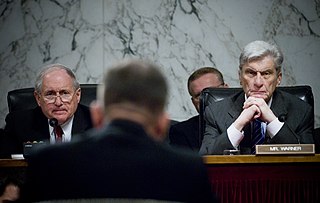
The United States Congress is the legislature of the federal government of the United States. It is bicameral, composed of a lower body, the House of Representatives, and an upper body, the Senate. It meets in the U.S. Capitol in Washington, D.C. Senators and representatives are chosen through direct election, though vacancies in the Senate may be filled by a governor's appointment. Congress has 535 voting members: 100 senators and 435 representatives. The U.S. vice president has a vote in the Senate only when senators are evenly divided. The House of Representatives has six non-voting members.

The federal government of the United States is the national government of the United States, a federal republic located primarily in North America, composed of 50 states, five major self-governing territories, several island possessions, and the federal district and national capital of Washington, D.C., where most of the federal government is based.
The United States Government Publishing Office is an agency of the legislative branch of the United States Federal government. The office produces and distributes information products and services for all three branches of the Federal Government, including U.S. passports for the Department of State as well as the official publications of the Supreme Court, the Congress, the Executive Office of the President, executive departments, and independent agencies.

The Congressional Budget and Impoundment Control Act of 1974 is a United States federal law that governs the role of the Congress in the United States budget process.

The Congressional Research Service (CRS) is a public policy research institute of the United States Congress. Operating within the Library of Congress, it works primarily and directly for members of Congress and their committees and staff on a confidential, nonpartisan basis. CRS is sometimes known as Congress' think tank due to its broad mandate of providing research and analysis on all matters relevant to national policymaking.
The United States budget process is the framework used by Congress and the President of the United States to formulate and create the United States federal budget. The process was established by the Budget and Accounting Act of 1921, the Congressional Budget and Impoundment Control Act of 1974, and additional budget legislation.
Contempt of Congress is the act of obstructing the work of the United States Congress or one of its committees. Historically, the bribery of a U.S. senator or U.S. representative was considered contempt of Congress. In modern times, contempt of Congress has generally applied to the refusal to comply with a subpoena issued by a congressional committee or subcommittee—usually seeking to compel either testimony or the production of requested documents.

A congressional committee is a legislative sub-organization in the United States Congress that handles a specific duty. Committee membership enables members to develop specialized knowledge of the matters under their jurisdiction. As "little legislatures", the committees monitor ongoing governmental operations, identify issues suitable for legislative review, gather and evaluate information, and recommend courses of action to their parent body. Woodrow Wilson once wrote, "it is not far from the truth to say that Congress in session is Congress on public exhibition, whilst Congress in its committee rooms is Congress at work." It is not expected that a member of Congress be an expert on all matters and subject areas that come before Congress. Congressional committees provide valuable informational services to Congress by investigating and reporting about specialized subjects.

The Congressional Record is the official record of the proceedings and debates of the United States Congress, published by the United States Government Publishing Office and issued when Congress is in session. The Congressional Record Index is updated daily online and published monthly. At the end of a session of Congress, the daily editions are compiled in bound volumes constituting the permanent edition. Chapter 9 of Title 44 of the United States Code authorizes publication of the Congressional Record.

The Congressional Gold Medal is the oldest and highest civilian award in the United States, alongside the Presidential Medal of Freedom. It is bestowed by vote of the United States Congress. The Gold Medal seeks to impart the highest expression of national appreciation for distinguished achievements and contributions by individuals or institutions.
In United States parliamentary procedure, a discharge petition is a means of bringing a bill out of committee and to the floor for consideration without a report from the committee by "discharging" the committee from further consideration of a bill or resolution. The signatures of an absolute majority of House members are required.

The clerk of the United States House of Representatives is an officer of the United States House of Representatives, whose primary duty is to act as the chief record-keeper for the House.
The Budget Enforcement Act of 1990 (BEA) was enacted by the United States Congress as title XIII of the Omnibus Budget Reconciliation Act of 1990, to enforce the deficit reduction accomplished by that law by revising the federal budget control procedures originally enacted by the Gramm–Rudman–Hollings Balanced Budget Act. The BEA created two new budget control processes: a set of caps on annually-appropriated discretionary spending, and a "pay-as-you-go" or "PAYGO" process for entitlements and taxes.

A conference committee is a joint committee of the United States Congress appointed by the House of Representatives and Senate to resolve disagreements on a particular bill. A conference committee is usually composed of senior members of the standing committees of each house that originally considered the legislation.
The United States Congressional Serial Set began in 1817 as the official collection of reports and documents of the United States Congress. The collection was published in a "serial" fashion, hence its name. It has been described as the "nation's most treasured publication" and beloved by librarians as "part of their most valued holdings."
A United States congressional hearing is the principal formal method by which United States congressional committees collect and analyze information in the early stages of legislative policymaking. Whether confirmation hearings, legislative, oversight, investigative, or a combination of these, all hearings share common elements of preparation and conduct. Hearings usually include oral testimony from witnesses and questioning of the witnesses by members of Congress. George B. Galloway termed congressional hearings a goldmine of information for all the public problems of the United States. A leading authority on U.S. government publications has referred to the published hearings as "the most important publications originating within Congress." The Senate Library in a similar vein noted "Hearings are among the most important publications originating in Congress."
An earmark is a provision inserted into a discretionary spending appropriations bill that directs funds to a specific recipient while circumventing the merit-based or competitive funds allocation process. Earmarks feature in United States Congress spending policy, and they are present in public finance of many other countries as a form of political particularism.

GovTrack.us is a website developed by then-student Joshua Tauberer. It is based in Washington, D.C., and was launched as a hobby. It enables its users to track the bills and members of the United States Congress. Users can add trackers to certain bills, thereby narrowing the scope of the information they receive. The website collects data on members of Congress, allowing users to check members' voting records and attendance relative to their peers. It propagates the ideology of increasing transparency in the government and building better communication between the general public and the government. The website was briefly "on pause" in September 2020 in protest of then-President Donald Trump's refusal to commit to a peaceful transition of power regarding the 2020 U.S. Presidential Election.

Procedures of the United States Congress are established ways of doing legislative business. Congress has two-year terms with one session each year. There are rules and procedures, often complex, which guide how it converts ideas for legislation into laws.
In the United States Congress, a bill is proposed legislation under consideration by either of the two chambers of Congress: the House of Representatives or the Senate. Anyone elected to either body can propose a bill. After both chambers approve a bill, it is sent to the President of the United States for consideration.










